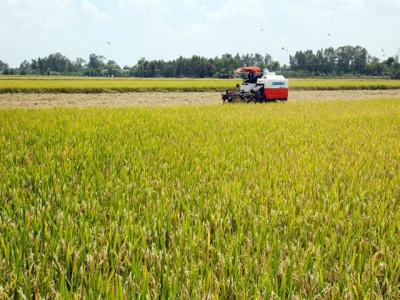Việt Nam Food Association demands priority clearance for rice stuck at ports

Ho Chi Minh City — The Việt Nam Food Association has petitioned authorities to prioritise customs clearance of consignments of rice exports stuck at ports.
A rice field in the Cửu Long (Mekong) Delta. The Việt Nam Food Association has petitioned authorities to prioritise customs clearance of consignments of rice exports stuck at ports. — VNA/VNS Photo Lê Minh
It has also urged them to cancel the customs declarations of exporters who submitted declaration forms with high volumes but could not prove they had them ready for export when inspected.
The Government recently approved resumption of rice exports, but capped them at around 400,000 tonnes for April with an eye on national food security amid the Covid-19 pandemic.
On April 12 the General Department of Customs began accepting online customs declarations from rice exporters, but many were left disappointed since the quota of 400,000 tonnes was reached within just three hours.
Many firms with rice consignments stuck at ports were unable to submit declarations.
The business group said some 300,000 tonnes of rice are now stuck at ports, and authorities should create conditions for enterprises to complete customs clearance as soon as possible.
It also suggested that the customs department should consider classifying consignments at ports into those that would go through a green channel, meaning exemption from inspection, and yellow channel, meaning partial inspection, for quick clearance.
The Government should scrap all limits on exports of sticky and organic rice since they do not affect domestic food security, it said.
Checking the actual rice volume, number of containers and seal numbers is imperative to ensure the information is exactly as enterprises declared in customs declaration forms, and if authorities detect false declarations, they should cancel and sanction the firms, it said.
Nguyễn Ngọc Nam, chairman of the VFA, said with their rice stuck at exit points, enterprises have to bear huge costs.
Besides, businesses that do not deliver on time have to compensate their foreign buyers, he said.
So if the above consignments are not cleared and exported, businesses would suffer losses of billions of đồng, threatening their very survival, he said.
The VFA said: “Some enterprises will not have revenues to pay loans in time if they cannot get customs clearance and export their rice in April and May.
"This will ... threaten their survival.”
Sticky rice export
The Ministry of Agriculture and Rural Development (MARD) has urged the Ministry of Industry and Trade (MoIT) to allow resumption of sticky rice exports from the last winter-spring crop, and advise it on the supply and demand status to adjust the cultivation area and output.
On April 15 MoIT asked MARD if sticky rice is a part of the national rice reserve and the impact of sticky rice grown in Long An and An Giang provinces, the biggest producers, on national food security.
It also sought information about the area under glutinous rice in the two provinces and expected output, and recommendations for the export of sticky rice.
Related news
 Agriculture ministry proposes maintaining sticky rice exports
Agriculture ministry proposes maintaining sticky rice exports The Ministry of Agriculture and Rural Development (MARD) on April 16 proposed continuing exports of sticky rice harvested from the 2019-2020 winter-spring crop.
 Vietnam and China seek to bolster agricultural trade amid COVID-19
Vietnam and China seek to bolster agricultural trade amid COVID-19 The main topic under discussion during the meeting was ways in which to open up more markets for agro-forestry-fishery products
 Dong Thap struggles to seek market for mango during Covid-19 pandemic
Dong Thap struggles to seek market for mango during Covid-19 pandemic The Industry and Trade Department in the Mekong Delta Province of Dong Thap has been wrestling to seek market for agricultural products especially mango amid